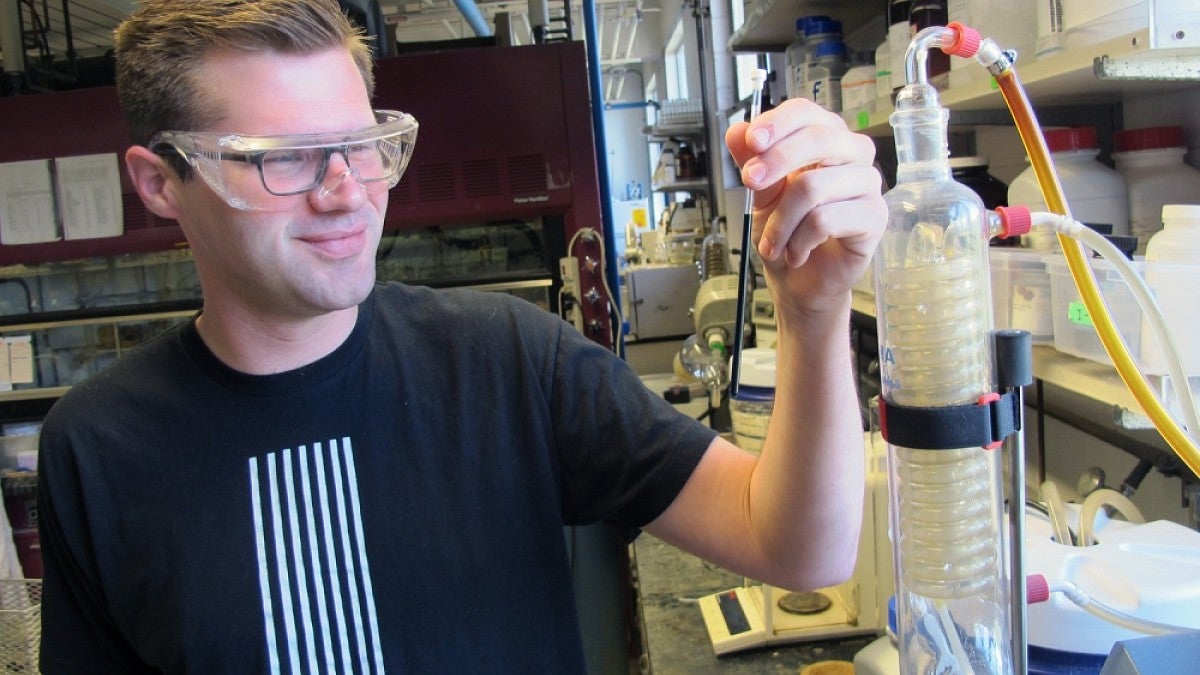UO doctoral student Gabe Rudebusch didn't let the fact that his mentor was off on a Humboldt Foundation-sponsored sabbatical in Germany hold him back. He moved forward with research in Mike Haley's chemistry lab and built a stable carbon-based molecule that offered properties sought by scientists for a century.
The molecule, which is produced in solution, carries a tongue-twisting name, diindenoanthracene, which carries a simpler acronym, DIAn [pronounced like the name Diane]. The molecule can transform itself as it goes from room temperature to high heat and back again without degrading.
That stability is vital to where DIAn may potentially land — as light-absorbing or semiconducting material in tomorrow's solar cells and electronic devices.
At high heat, the molecule is able to change its electron bonding patterns to what researchers call a magnetic biradical state. It then returns to a fully bonded, nonmagnetic, closed state at room temperature. In the chemistry world, that means it goes from a closed-shell material at room temperature to an open-shell material at high temperature.
Biradical refers to organic compounds that have two free-flowing electrons. Producing such compounds using techniques to control their electron spin, and thus provide semiconducting properties, has been hampered by instability towards oxygen and heat since the first synthetic biradical hydrocarbon was made in 1907.
"Potentially our approach could help to make organic solar cells more efficient than silicon solar cells, but that's probably far in the future," said Rudebusch, lead author on a paper about the research in the Nature Chemistry. "Our synthesis is rapid and efficient. We easily can make a gram of this compound, which is very stable when exposed to oxygen and heat. This high stability for biradical compounds is almost unheard of in the literature."
The proof-of-concept paper details the four-step synthesis of DIAn, its characterization, and how it held up when tested in semiconducting materials by collaborators in Japan, Spain and Sweden.
The molecular framework for the new molecule involves the hydrocarbon anthracene, which has three linearly fused hexagonal benzene rings, in combination with two five-membered pentagonal rings.
"The big difference between our new molecule and a lot of other biradical molecules that have been produced previously is those five-membered rings," said Haley, a paper co-author and holder of the Richard M. and Patricia H. Noyes Professorship in Chemistry. "They have the inherent ability to accept electrons or give up electrons. This means DIAn can move both negative and positive charges, which is an essential property for useful devices such as transistors and solar cells."
Haley's lab is now seeking to develop derivatives and larger versions of the new molecule to help move the technology forward into potential applications.
Rudebusch, meanwhile, has successfully defended his doctoral thesis for his work in the Department of Chemistry and Biochemisty and heads to the University of Illinois at Urbana-Champaign in July for a postdoctoral position.
The National Science Foundation supported the research done at the UO during the project.
—By Jim Barlow, University Communications


